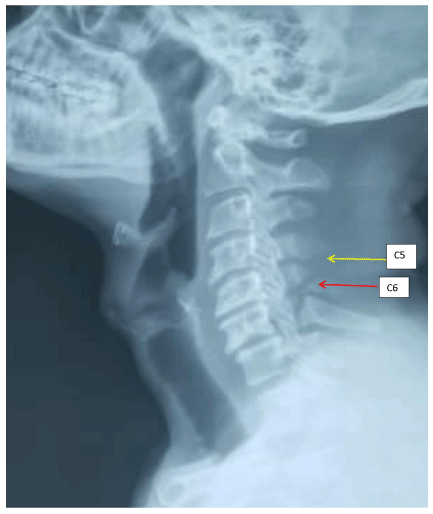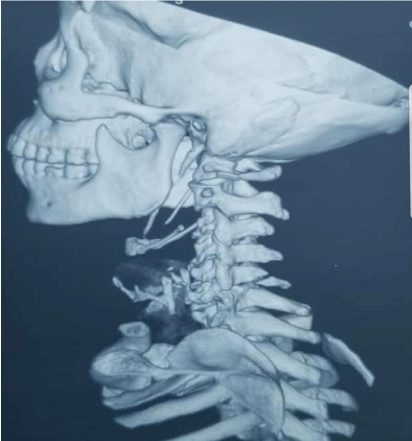International Journal of Spine Research
Atypical presentation of clay shoveler’s fracture: A case report and literature review
Owolabi IJ*, Onuoha KM, Alade OA and Shobode MA
Cite this as
Owolabi IJ, Onuoha KM, Alade OA, Shobode MA (2020) Atypical presentation of clay shoveler’s fracture: A case report and literature review. Int J Spine Res 2(1): 051-053. DOI: 10.17352/ijsr.000014Clay shoveler’s fracture causes disruption of the spinous processes at C6 to T3 spinal vertebrae.
This is a case report of an atypical clay shoveler’s fracture from Babcock university teaching Hospital ,Ogun-state, Nigeria. It involved a 62-year-old male travelling in the south-western region of Nigeria who was invloved in a Road traffic accident and presented with pain at the posterior aspect of the neck.
X-ray and 3D oriented CT scan confirmed the fractures with lateral views being the most favored.
Classical Clay shoveler’s fracture usually has no neuromuscular deficit since it is a stable fracture and involves only the posterior spinal column based on the Denis classification for 3 column concept for stable and unstable fractures of the spine.
When a fracture involves the spinolaminar line it’s proximity to the spinal cord and risk of neurological deficit must be adequately ruled out.
This report evaluates the mechanism of injury, treatment given and prognosis of the patient involved.
Abbreviations
CT: Computed Tomography; MRI: Magnetic Resonance ImagingIntroduction
Clay shoveler’s fracture is defined as a fracture that involves the Spinous processes of the lower cervical or upper thoracic vertebrae most commonly found at the midpoint between the spinolaminar line and tip of the Spinous processes of C6 -T3 spine levels with the most common occurring at C7 [1].
The name originated in the 1930s among clay miners in Australia who dug ditches and tossed clay, several feet above their heads with shovels. Instead of separating, the wet clay sometimes stuck to the shovel causing a sudden flexion force in the neck or back muscles resulting in the fracture. Some of the workers would feel a sudden pain between the shoulder blade which prevented them from working [1,2].
The mechanism of the injury involves excessive rotational forces exerted by the trapezius and rhomboid muscles attached to the Spinous process and reflex pull on the supraspinous ligament or through direct trauma to the posterior part of the neck in a flexed position [3,4].
This case report looks at fractures involving the Spinous process at C5 and spinolaminar line of C6 which makes it atypical as compared to the classical clay shoveler’s fracture which involves the spinous process of C6 -T3.
Classical clay shoveler’s fracture becomes atypical when it involves the Spinous process of other cervical or thoracic vertebrae not within C6-T3 [11].
Case report
A 62-year-old male farmer presented at the accident and emergency department with pain at the posterior aspect of the neck of 6 hours duration .He reported not using his safety belt while driving along the highway located in the southwestern region of Nigeria when he lost control which caused his car to somersault severally. He was propelled forward against the dashboard with the neck in a flexed position.
He had an intense neck pain which was graded as 8 with the numeric rating scale [5] . The pain radiated to his shoulders and upper back with limitations to flexion and extension of the neck.
There was no history suggestive of bleeding from any craniofacial orifices, no loss of consciousness, he also had no history of difficulty with breathing nor dizziness, no history of weakness in the upper or lower limbs.
He was managed using the Advanced Trauma Life Support (ATLS) protocol with a Glasgow coma scale of 15/15,airway was clear ,oxygen saturation was 96% at room air and a blood pressure of 120/80mmHg. He had tenderness at the posterior aspect of the neck, devoid of swelling nor bruise, no differential warmth, normal gait, sensation was normal, power was 4 /5 on his upper and lower limbs, normal muscle tone , tendon reflexes were adequate and had a normal score (grade E) for neurological function based on the American Spinal Injury Association (ASIA) impairment scale [6].
Intravenous access was secured with necessary blood samples taken. His neck was stabilized with a Philadelphia Cervical Orthosis and was sent for trauma series X-rays and a cervical 3D reconstruction CT scan.
He was admitted into the orthopedic ward and treated conservatively with a Philadelphia Cervical Orthosis with analgesics and muscle relaxants administered.
He was observed at the hospital for 1 week post trauma to check for signs of Neurological deficit which were all absent.
Importance was taken to monitor signs of neurological deficit by keeping a daily chart of his power, tone ,reflexes and sensation due to the location of the injury.
Follow up in the outpatient department was done for 8 weeks and was uneventful with no complications. He was also advised not to engage in any form of vigorous activity for the said period of time.
Discussion
Clay shoveler’s fracture though rarely reported is a well known pathology in orthopedics [7].
Fracture of the cervical spinous process is not common , a study by Stiell found only 12 of these fracture pattern,examining 8924 stable patients with blunt trauma to the head or neck during a study done in Canada [8].
However some reported cases from other countries within this region have been cited [9].
Trauma is the most common cause for vertebral fractures in most of the cases involved [10].
The usual mechanism of injury being sudden neck hyperflexion was also the possible scenario in this patient as the car summersaulted several times.
Factors that would have contributed to this fracture include senile osteoporosis based on the age of the patient involved.
This report is similar to a study done by Feldman VB which reported an atypical clay shoveler’s fracture involving the spinolaminar line of C7 [11].
X-ray of this patient showed an oblique lucency with posterior displacement of the C5 Spinous process, a fracture line also extended into the spinolaminar line of C6 cervical vertebra and loss of cervical lordosis due to muscle spasms (Figure 1).
A CT scan was required in this patient to further delineate the characteristics of the fracture and also identify occult fractures not seen on x-rays (Figure 2). This was important due to the location of the injury and possible spinal cord involvement as he sustained an oblique fracture at the spinolaminar line of the C6 cervical vertebra (Figure 2).
An MRI was not indicated for in this patient as he made good clinical improvement had no sign of neurological deficit. The role of MRI cannot be ignored in cases that involve neurological deficit following blunt trauma to the spine as it is a good modalty for assessing soft tissue damage within the spinal canal [12].
Concerning stability, the fracture pattern is quite stable since it only involved the posterior elements outlined by the Dennis classication of the 3 column concept and the treatment given to this patient remains the standard of care for stable fractures such as this and surgery is not indicated as documented in literature [13].
The prognosis for clay shoveler’s fracture are favorably good based on reports worldwide [14].
However the risk of non-union and malunion of the fractured Spinous process still remains in medical literature due to the muscular pull in this region [15].
Differential diagnosis
Some Common conditions with similar clinical presentation include cervical strain (whip lash), central cord syndrome and acute Torticollis.
Conclusion
Atypical Clay shoveler’s fracture is a rare entity that can easily be missed if adequate triage and investigations are not carried out.
This case report evaluates an atypical clay shoveler’s from Nigeria following a road traffic accident and the presentation, investigations and treatment meets what is expected in literature.
He presented with an atypical clay shoveler’s fracture at the Spinous process of C5 and fracture at the spinolaminar line of C6 as opposed to the classical clay shoveler’s fracture which occurs at the midpoint of the Spinous processes of C6 to T3.
This report of an atypical clay shovelers fracture is similar to a study done by Feldman V.B [11].
The fracture was stable and only involved the posterior spinal column.
The patient made good clinical recovery after 8 weeks of conservative care using the Philadelphia Orthosis.
- Hall M (1940) Clay shoveler’s fracture. J Bone Joint Surg 12: 63-75.
- Herrick RT (1981) Clay shoveler’s fracture in power-lifting: a case report. Am J Sports Med 9: 29-30. Link: https://bit.ly/3kkBQi4
- Hetsroni I, Mann G, Dolev E, Morgenstern D, Nyska M (2005) Clay shoveler’s fracture in a volleyball player. Phys SportsMed 33: 38-42. Link: https://bit.ly/2DtKY3l
- Kang D, Lee S (2009) Multiple spinous process fractures of the thoracic vertebrae (Clay-Shoveler’s fracture) in a beginner golfer: a case report. Spine (Phila Pa 1976). 34: E534-E537. Link: https://bit.ly/3knzJu0
- Harrick CT, Kovan JP, Shapiro (2003) The numeric rating scale for clinical pain. Measurement: A ratio measure?. Pain Pract 3: 310‐316. Link: https://bit.ly/3fzwcoQ
- Kirshblum SC, Burns SP, Biering-Sorensen F, Donovan W, Graves DE, et al. (2011) International standards for neurological classification of spinal cord injury (revised 2011). J Spinal Cord Med 34: 535-546. Link: https://bit.ly/33yLfg4
- Rowe LJ (1987) Clay shoveler’s fracture. ACA J Chiropractic 21: 83-86.
- Stiell IG, Wells GA, Vandemheen KL, Clement CM, Lesiuk H, et al. (2001) The Canadian C-spine rule for radiography in alert and stable trauma patients. JAMA 286: 1841-1848. Link: https://bit.ly/3a2BZCd
- Akhaddar A, Mandour C (2013) Multiple contiguous cervicothoracic clay shoveler’s fracture (C6 to T9 spinal vertebrae). Pan Afr Med J 16: 128. Link: https://bit.ly/2XCSCiW
- Whitney E, Alastra AJ (2020) Vertebral fracture. Link: https://bit.ly/33Aa37m
- Feldman VB, Astri F (2001) An Atypical clay shoveler fracture :A case report. J Can Chiropr Assoc 45: 213-220. Link: https://bit.ly/3fCwICq
- Utz M, Khan S, O’Connor D, Meyers S (2013) MDCT and MRI evaluation of cervical spine trauma. Insights into Imaging 5: 67-75. Link: https://bit.ly/2Xyz5zW
- Zhang A, Chauvin BJ (2019) Denis Classification. Treasure Island (FL). Link: https://bit.ly/33EhrP4
- Posthuma de Boer J, van Wulfften Palthe AF, Stadtholder A, Bloomers FW (2016) The Clay Shoveler's Fracture: A Case Report and Review of the Literature. J Emerg Med 51: 292‐297. Link: https://bit.ly/3inKQ4p
- Murphy RF, Hedequist D (2015) Excision of symptomatic spinous process nonunion in adolescent athletes. Am J Orthop (Belle Mead NJ). 44: 515‐517. Link: https://bit.ly/31r83eV
Article Alerts
Subscribe to our articles alerts and stay tuned.
 This work is licensed under a Creative Commons Attribution 4.0 International License.
This work is licensed under a Creative Commons Attribution 4.0 International License.



 Save to Mendeley
Save to Mendeley
